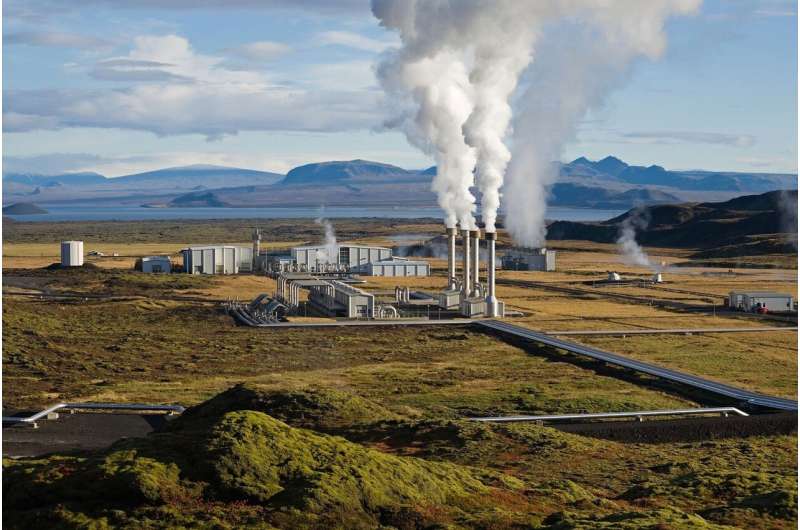This article has been reviewed according to Science X's editorial process and policies. Editors have highlighted the following attributes while ensuring the content's credibility:
fact-checked
trusted source
proofread
Using AI to pinpoint hidden sources of clean energy underground

As efforts to transition away from fossil fuels strengthen the hunt for new sources of low-carbon energy, scientists have developed a deep learning model to scan the Earth for surface expressions of subsurface reservoirs of naturally occurring free hydrogen.
Researchers used the algorithm to help narrow down the potential whereabouts of ovoids or semicircular depressions (SCDs) in the ground that form near areas associated with natural or "gold hydrogen" deposits. Though these circular patterns often appear in areas of low elevation, they can be hidden by agriculture or other vegetation. Recent discoveries of these circles in the U.S., Mali, Namibia, Brazil, France, and Russia have unveiled that they exist in greater numbers than previously thought.
To help uncover these nearly invisible semicircular depressions, two recent papers describe how lead authors Sam Herreid and Saurabh Kaushik, both postdoctoral scholars at the Byrd Polar and Climate Research Center at The Ohio State University, combined their model with global satellite imagery data to identify SCDs.
Their team compiled a list of known SCD locations to train their algorithm to search the globe. After using remote sensing data to analyze what these sites look like from above, they drew on geomorphic and spectral patterns to determine what sites around the world are most likely to be associated with SCDs related to geologic hydrogen.
Through their observations, the project found that AI demonstrates a unique ability to map out surface expressions of potential subsurface hydrogen reservoirs around the world, as well as establish a baseline for further investigation of hydrogen-associated sites. Their work was presented this week at poster sessions at the annual meeting of the American Geophysical Union.
Scientists have long been aware of hydrogen's potential as one of nature's cleanest and most efficient energy sources. Now, as governments invest in cleaner alternatives, interest in natural hydrogen is rapidly surging, said Joachim Moortgat, the project's principal investigator and an associate professor of earth sciences at Ohio State.
"Hydrogen in general is a very attractive energy source," Moortgat said. "If you burn it, its only by-product is water, and unlike wind or solar energy, hydrogen can be stored and transported, so there are all kinds of industries trying hard to make the switch."
Since gold hydrogen is also produced continuously within Earth's crust, some believe that access to a low-carbon energy resource that is nearly devoid of greenhouse gas emissions could reshape the global energy landscape. Yet researchers have found that locating hydrogen requires the development of new exploration tools, said Moortgat.
"One reason they're difficult to find is that they probably occur in different kinds of geologies and locations than where you would find oil or gas," he said. "But with the AI tools we develop, we map everything that could potentially be an SCD."
Unfortunately, while researchers can use satellite data to narrow down areas of interest, real hydrogen deposits can easily be confused for other circular-looking land features, such as lakes, golf courses or crop circles.
And as countries scramble to expedite the search for hydrogen sources, many of them are already developing new ways to access this promising new energy, said Herreid.
"This work feels like it's contributing in a proactive sense to mitigating the climate crisis," said Herreid, a glaciologist who previously used AI to assist with modeling the impact of climate change on glaciers. "It's very exciting to be involved in a project that's really rapidly evolving."
Abroad, Europe is already working on ways to take advantage of their stores of gold hydrogen, and at home in the U.S., laws like the Inflation Reduction Act include provisions to expand the clean energy production industry.
Despite how fast-moving the field seems, it'll take at least a few more years before natural hydrogen reservoirs are successfully integrated as a reliable source of clean energy. To that end, what researchers should focus on now is how they should go about deepening our understanding of these hydrogen systems, said Moortgat.
"The biggest challenge is that we need to find more SCDs and then really investigate how these things form," he said. "Once we discover a lot more, we will be in a better position to again use AI tools to find similar ones worldwide."
More information: Paper: agu.confex.com/agu/fm23/meetin … pp.cgi/Paper/1312027
















